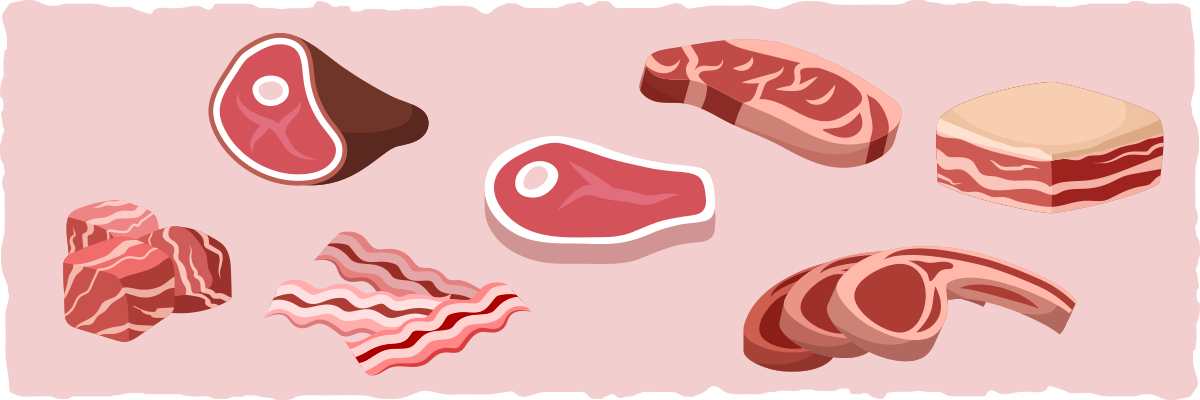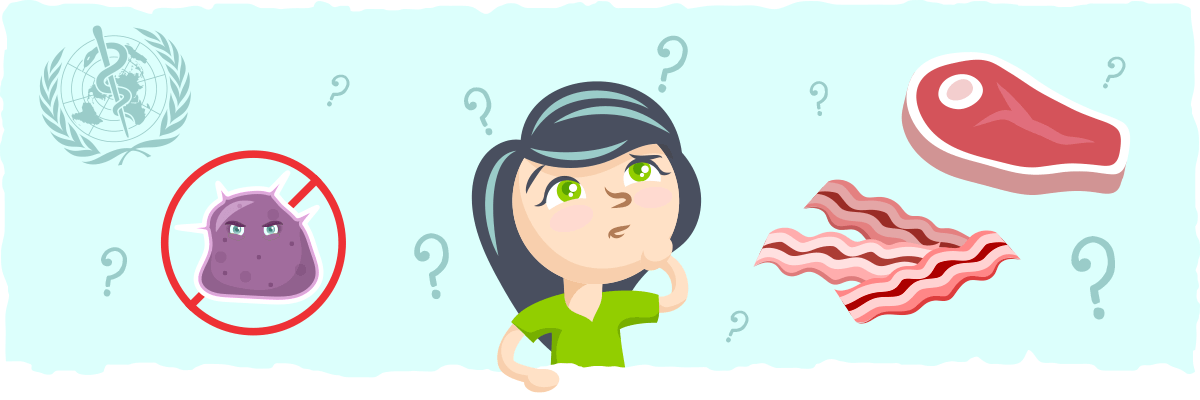You have been bombarded with headlines about the World Health Organization report from October 2016 claiming that red meat causes cancer. That certainly seems like a blow to bacon lovers and strict keto dieters who eat lean pork daily.
However, when we dig deeper into the science, we can clearly see that their ruling is scientifically questionable. Below we document the WHO’s faulty verdict and how you can further maximize your ketogenic diet to improve your health.
What is Red Meat?

We need to first know what red meat is before we start evaluating the research. Red meat is any meat derived from the flesh of mammals such as cow, sheep, goat, or pigs. [1] It excludes meat from birds, typically known as poultry or “white meat”, and marine sources, typically known as fish. [1]
Red meat has several unique properties compared to other meat sources. As expected, it is typically red when raw. This is because it high in a reddish compound found in muscles called “myoglobin” which binds to oxygen released from the blood stream. Mammals have high levels of myoglobin in their muscles because they frequently participate in low-energy activities such as grazing.
In contrast, white meat from poultry is made of fast-twitch muscle fibers that allows muscles to produce quick bursts of activity such as flying. They contain little myoglobin because energy is derived from glycogen. Dark meat in poultry has high levels of myoglobin is called “dark meat” and is typically grey- not red.
Red meat is also high in a compound found in the blood called hemoglobin which delivers oxygen to tissues throughout the body. Hemoglobin is also high in iron, an essential nutrient with important functions in the body.
Not all red meat is actually red. When cooked, pork is typically white. However, because it is derived from a mammal and has similar nutritional properties to other red meat (such as high myoglobin and iron content) it is classified as a red meat. Examples of red meat included:
- Pork
- Beef
- Lamb
- Goat
- Veal
- Venison (deer)
Red meat does not include:
- Chicken
- Turkey
- Goose
- Game birds such as pheasant and quail
- Duck
- Rabbit
- Any marine-based meat such as fish or oysters
- Eggs of any sort
According to Market Watch, the average American consumed about 105.3 pounds of red meat. About 99% of this meat was beef (55 lbs) or pork (49.2 lbs).
Red meat can generally be classified into three main categories that have different chemical compositions. As a result, consuming each of them has unique health implications.
Processed Meat
Meat that has been modified by methods that involve chemicals to increase shelf life or change taste is considered to be processed meat. Marinating meat overnight or grinding it does not make it “processed”- it needs to be changed more than that.
Processes that chemically modify meat include curing, smoking, fermenting, adding preservatives such as nitrates, or salting with a salt such as sodium chloride. Examples of processed meats include bacon, hot dogs, salami, beef jerky, pates, ham, canned meat, and meat-based sauces. Ground beef and lamb are not examples of processed meat.
It is important to note that while processed meat is usually red meat, chemically modified poultry fall under the broad umbrella of processed meat. Thus, turkey bacon and chicken sausage are both considered to be processed.
Organic and Free Range
We have all heard of the term “organic”. But what does it actually mean? According to the United States Department of Agriculture (USDA), organic meat comes from mammals that are raised in living conditions that accommodate their natural behaviors to some degree (such as grazing in open pasture) not provided artificial hormones or antibiotics, and fed 100% organic vegetable feed.
Meats that are produced organically are certified by the USDA. Processed meats can also be organic. However, they will not contain artificial preservatives such as nitrates and only natural substances such as salt.
Another common form of meat is “free-range.” This terms only indicates that animals have the ability to graze outdoors. It does not address the food sources, any hormones or chemicals the animals are provided, or even how much. Thus, free-range is considered to be a less stringent classification than organic.
It is important to note that terms such as “organic” and “free-range” only refer to how food is produced- not its nutritional quality. According to recent research organic foods have been found to have, at most, minimal differences in nutrition and taste with inorganic foods.
That being said, the fact that organic food is free of artificial preservatives such as nitrates warrants special attention when determining its role in increasing the risk of developing cancer.
Unprocessed, Non-organic
Meat that is unprocessed but not certified as organic or free-range is referred to as unprocessed, inorganic meat. The bulk of meat consumed in the United States and world falls under this category. [1]
Key Takeaways: Red meat is derived from the flesh of mammals such as cows or pigs. It is high in a reddish, muscle-building protein called myoglobin as well as hemoglobin and iron. Red meat comes in three chemically distinct forms: processed, organic, and non-organic unprocessed. Each has its own unique implications for the human body.
So, What Did the WHO Actually Say about Red Meat?

Last month the WHO released an infamous press release showing an association between red meat and the formation of cancer. The full research study can be found here.
But what is the deal behind the paper and what did it actually say?
In October of 2015, 22 scientists from ten different countries at the International Agency for Research on Cancer (IARC) in Lyon, France to evaluate the. The IARC is an arm of the WHO that provides recommendations on agents that may cause cancer such as tobacco and asbestos.
The WHO analyzed over 800 studies. Most of them were observational in nature- meaning that they examined how much red meat subjects over time and saw if they developed cancer. Overall, the studies contained hundreds and thousands of subjects.
After examining the data, the WHO classified processed red meat as a “Group 1 carcinogen” for colorectal cancer, the third leading cause of cancer deaths in the US. [2] According to the WHO this means that there is a strong amount of research to suggest an association between consuming processed red meat and developing at least one form of cancer.
Other group 1 carcinogens include tobacco and asbestos. Inorganic, unprocessed red meat was classified as a “Group 2A carcinogen” meaning that regular consumption of it probably increases one’s risk of cancer. However, the research isn’t as rigorous to formally classify it as a Group 1 carcinogen. Because there haven’t been many studies on organic meat, the WHO did not provide an individual assessment.
It is important to clarify a couple of things. First, processed red meat and inorganic, unprocessed red meat were classified as a group 1/group 2A carcinogen with respect to only colorectal cancer. This is still important- colorectal cancer is the third most prevalent form of cancer worldwide. [3]
However, The WHO stated that these findings cannot be generalized to the many other forms of cancer. Thus, the widespread headlines saying that “red meat causes cancer headlines” is an incorrect interpretation of the WHO’s findings.
Second, the WHO stressed that the dose makes a big impact on cancer risk. That means that eating 3 servings of fatty bacon per day is a lot worse than eating a small bison burger for lunch every day. However, they didn’t provide recommendations on how much meat one should consume.
Putting in In Perspective: Flaws in the WHO Research
The WHO is a highly-credible organization that has made impactful contributions to the field of global health and medical research.
However, that doesn’t mean everything they say is 100% accurate.
Below we break down the four main problems with their research and show why a ketogenic diet is still a healthy lifestyle choice.
The Research Wasn’t that Strong
At first glance, the research seems quite compelling. After all, they examined data from 800 large epidemiological studies that tracked hundreds and thousands of subjects. However, epidemiological studies are not typically regarded as the most credible studies.
This is because even after controlling for other potential factors, it is difficult to isolate the impact a specific variable (such as red meat) has on a specific outcome (i.e. colorectal cancer). Additionally, it does not account for “confounding variables”, a variable associated with both the variable interest (i.e. red meat).
For example, perhaps heavy red meat eaters could be more inclined to participate in unhealthy habits such as smoking or low exercise that contribute to the development of cancer. Maybe in one study, some subjects only ate high-fat, salty bacon two times a day while in other subjects ate lean, organic pork tenderloin an average of once a day.
These variations that may impact the incidence of colorectal cancer are not distinguished in the bulk of the studies the WHO assessed. And that makes it difficult to fully pinpoint to what extent red meat played a role in contributing to the risk of colorectal disease.
Ideally, the WHO would have based their assessment on at least several “randomized controlled” trials in which two groups with identical lifestyle and behaviors were followed and one fed red beef and the other an equal calorie alternative. To be fair: this is quite difficult to do because cancer takes a while to develop.
The WHO even acknowledges the limitations of their research at least in regards to unprocessed red meat. According to the WHO, the association between consuming unprocessed, non-organic red meat and the risk of developing colorectal cancer is based on “limited evidence from epidemiological studies showing positive associations between eating red meat and developing colorectal cancer.”
They go on to explain that “limited evidence means that a positive association has been observed between exposure to the agent and cancer but that other explanations for the observations (technically termed chance, bias, or confounding) could not be ruled out.” [2] This means that despite the small association, the research is not strong to say that eating red meat causes colorectal cancer.
Thus, the association between colorectal cancer- which is just one form of cancer- and standard red meat is quite limited in scope.
Finally, the WHO didn’t provide any assessment of organic, unprocessed red meat. Recall that this meat is often free of harmful preservatives associated with increased risk of cancer. However, it was not assessed independently whatsoever by the WHO.
Given the fact that unprocessed, non-organic meat was weak in evidence, we could anticipate that organic red meat contributes even less to the development of colorectal cancer than processed red meat and inorganic red meat.
Key Takeaways: The WHO based their assessment only on observational studies. This makes it harder to establish a clear association between eating red meat and the incidence of cancer. Additionally, they acknowledged their limited research on unprocessed, non-organic meat and did not assess the impact of preservative-free, organic red meat on the risk of developing colorectal cancer.
The Risk of Processed Meat Isn’t that Great
The WHO classified processed red meat as a Group 1 carcinogen along with smoking, alcohol, and asbestos. So this means that it’s just as dangerous for you, correct?
The WHO classifies compounds as group 1 carcinogens when “there is sufficient evidence of carcinogenicity in human.” [4] We already assessed why the evidence isn’t that strong.
However, even assuming that processed red is “carcinogenic”, it contributes very minimally to the risk of developing colorectal cancer.
For example, if an individual consumed 2.0 ounces of processed meat per day (which is about 4 big strips of bacon) for at least twenty years, he or she increases their risk of colorectal cancer goes up by 20 percent over what it would have been if you didn’t eat processed meat at all. [2]

However, the risk for colorectal cancer risk is already quite low unless you already have a genetic predisposition towards developing it. Thus, the actual increase is quite minimal.
In contrast, if you smoke one cigarette per day, you increase your risk of developing colorectal cancer by 120%- 6 times more than eating a high amount of processed meat daily. [5] When comparing the risks of developing colorectal cancer, oncologist Steven Clinton stated in an NPR interview that processed meat “contributes a much more modest risk” than cigarette smoking and that eating processed meat “is not even in the same ballpark as cigarette smoking.”
And, as previously stated, the WHO only links processed meat with one form of cancer. Other known carcinogens, such as tobacco smoking and asbestos, not only increase the risk of colorectal cancer much more but also increase the risk of many other forms of cancer ranging from lung to heart. And remember: The evidence is even weaker for inorganic, unprocessed meat and not established for organic meat!
Key Takeaway: According to the WHO’s methodology, eating processed red meat minimally increases the risk of developing colorectal cancer especially compared to higher risk factors such as smoking. Additionally, this risk is even weaker for other forms of red meat.
Red Meat Has Unique Health Benefits
The WHO report spends a lot of time looking at research (that isn’t even very compelling) showing that processed red meat slightly increases risk of colorectal cancer. However, it overlooks the unique nutritional benefits of red meat.
According to the USDA food composition database, 100 grams of lean pork tenderloin contains 121 calories, 22 grams of protein, and just 1 gram of saturated fat. It is also a good source of minerals such as Iron, Zinc, Potassium, Riboflavin, and a very good source of Thiamin, Vitamin B6, Phosphorous, Niacin, and Selenium.
Red meat is also typically high in vitamin B12, a very important nutrient that is not found in plants that helps maintain optimal nerve system function. [6] Beef is one of the best sources of vitamin B12 and it cannot be found in non-meat products. [6]
Several useful compounds are highly prevalent in red meat. One is creatine, which stores energy in muscles and increases muscular strength. Another is a powerful antioxidant called carnosine. Red meat is also a good source of omega-3 fatty acids which are known to have many positive health benefits on the body.
Key Takeaways: Red meat is a nutritionally-rich dense source of protein, micronutrients such as vitamin B12, and compounds such as creatine. Lean cuts of organic red meat are particularly healthy as they are high in protein and low on preservatives and unhealthy fats.
Temperature Used to Cook Red Meat was Not Evaluated
The WHO also failed to take into account other controllable factors that impact the carcinogenicity of red meat. One in particular is the temperature used to prepare red meat. According to the WHO, “high-temperature cooking methods generate compounds that may contribute to carcinogenic risk.” [2]
A study from last month published in the Journal of Cancer on 1,358 subjects observed an association between the incidence of cancer and eating meat cooked at high temperature. [7]
Other studies, including one on red meat and colorectal cancer and another on kidney cancer, also support these findings [8, 9] These studies examined high-temperature cooking methods such as charring, pan-frying, and deep-frying.
So, how can you cook meat without blasting it with heat? The most common low risk methods of preparing red meat are broiling and baking. A trendy method of cooking is using a crock pot to cook meat typically in the 200 F – 300 F range. This is an excellent way to make flavorful stews that with minimal added fat for cooking.
A particularly interesting method of safely preparing meat is called “sous-vide”, a French style in which foods is sealed in plastic bags free of air and then placed in a temperature-controlled steam environment such as a water bath. Typically, the temperature of the cooking environment is about 131 F (55 C) to 140 F (60 C)- which is much lower than even the low heat methods above.
Check out our recipe section to find out more ways to make healthy, slow cook red meat dishes!
Still Concerned about Red Meat? Add More Fish and Poultry
While the WHO study showing an association wasn’t particularly strong (especially for organic red meat cooked at lower temperatures), you still may be interested in cutting down your red meat consumption. And that is fine, as other keto-friendly meat sources have unique health benefits.
Very little research has uncovered an association between the consumption of fish and poultry and increased risk of cancer. [10] These meat sources are also typically leaner than red meats and contain healthier fats. If you are going to eat poultry, try to choose unprocessed varieties and avoid eating the skin as it is unhealthy and one study has linked it to a slightly higher association with cancer. [11]
Plenty of research suggests that consuming certain kinds of fish are particularly healthy for you.

Fatty fish such as mackerel, tuna, and sardines, are high in a compound called omega-3 fatty acids which help reduce the risk of cardiovascular illnesses such as stroke. [12] The University of Maryland also outlines a whole host of other benefits from eating a diet high in omega-3 fatty acids.
Cutting Through the (Red) Meat: The Truth behind the WHO’s Verdict
By saying that red meat causes cancer, the WHO certainly scared meat lovers and ketogenic dieters everywhere. However, when you break down the science behind their verdict that red meat causes cancer, it doesn’t really add up.
First, the association between red meat and developing cancer isn’t that strong. Most of the studies evaluated were epidemiological in nature which cannot establish a clear causal relationship between eating red meat and causing cancer. Additionally, they focused primarily on one form of cancer- colorectal- and barely touched upon other forms of cancer.
Second, regularly consuming red meat barely increases your risk of developing colorectal cancer. At most, regular consumption of processed red meats such as bacon and salami increase the chance of developing cancer by 18% while smoking daily increases the risk by 2500%. Additionally, this risk is based on even more “limited data” for unprocessed red meat and virtually unestablished for high-quality, free-range organic meat.
Third, red meat itself has many health benefits that the WHO overlooked. Lean cuts of red meat are rich in macronutrients such as protein and healthy fats and contain important micronutrients such as zinc hand vitamin B12. And it has other healthy compounds such as creatine and omega-3 fatty acids that help with muscle building and maintaining great cardiovascular health.
Fourth, the studies that examined by the WHO did not account for variations in temperature used to prepare these meats. Science shows that red meat is more likely to increase certain forms of cancer when cooked at high-temperature methods. You can cook red meat through a variety of lower temperature methods such as broiling, baking, slow cooking, or sous-vide.
Finally, you can also consider adding other keto-friendly meats into your diet that have no research to indicate that they cause cancer. Lean poultry such as chicken and turkey breast can cut body fat and increase muscle. Fatty fish such as sardines and mackerel can protector cardiovascular health through their punch. Remember, though: It is important to not eat too many fish high in contaminants such as swordfish.
If you want to eat red meat, we suggest that you continue to do it along with a healthy, well-balanced ketogenic diet. It’s ok to eat some processed red meat, but don’t have too much because it is typically high in salt and unhealthy fats. Instead, strive to eat lean, organic red meat such as pork tenderloin. And it’s ok to splurge a little more on this, And, of course, remember to eat a well-balanced ketogenic diet with fats and protein derived from poultry, fish, and non-meat sources such as flax and walnuts as well as appropriate supplements!
List of References
- McAfee, Alison J., et al. “Red meat consumption: An overview of the risks and benefits.” Meat science 84.1 (2010): 1-13.
- Bouvard, Véronique, et al. “Carcinogenicity of consumption of red and processed meat.” The Lancet. Oncology (2015).
- World Cancer Report 2014. World Health Organization. 2014. pp. Chapter 1.1.
- International Agency for Research on Cancer (IARC). Agents Classified by the IARC Monographs, Volumes 1 – 114. 2015. Accessed at https://monographs.iarc.fr/ENG/Classification/List_of_Classifications_Vol1-114.pdf on October 27, 2015.
- Boyle, P. “Tobacco smoking and the British doctors’ cohort.” British journal of cancer 92.3 (2005): 419.
- Salwen MJ. Vitamins and trace elements. In: McPherson RA, Pincus MR, eds. Henry’s Clinical Diagnosis and Management by Laboratory Methods. 22nd ed. Philadelphia, PA: Elsevier Saunders; 2011:chap 26.
- Melkonian, Stephanie C., et al. “Gene‐environment interaction of genome‐wide association study‐identified susceptibility loci and meat‐cooking mutagens in the etiology of renal cell carcinoma.” Cancer (2015).
- Cross, Amanda J., et al. “A large prospective study of meat consumption and colorectal cancer risk: an investigation of potential mechanisms underlying this association.” Cancer research 70.6 (2010): 2406-2414.
- Stolzenberg-Solomon, Rachael Z., et al. “Meat and meat-mutagen intake and pancreatic cancer risk in the NIH-AARP cohort.” Cancer Epidemiology Biomarkers & Prevention 16.12 (2007): 2664-2675.
- English, Dallas R., et al. “Red meat, chicken, and fish consumption and risk of colorectal cancer.” Cancer Epidemiology Biomarkers & Prevention 13.9 (2004): 1509-1514.
- Le Marchand, Loïc, et al. “A case-control study of diet and colorectal cancer in a multiethnic population in Hawaii (United States): lipids and foods of animal origin.” Cancer Causes & Control 8.4 (1997): 637-648.
- Kris-Etherton, Penny M., William S. Harris, and Lawrence J. Appel. “Fish consumption, fish oil, omega-3 fatty acids, and cardiovascular disease.”circulation 106.21 (2002): 2747-2757.